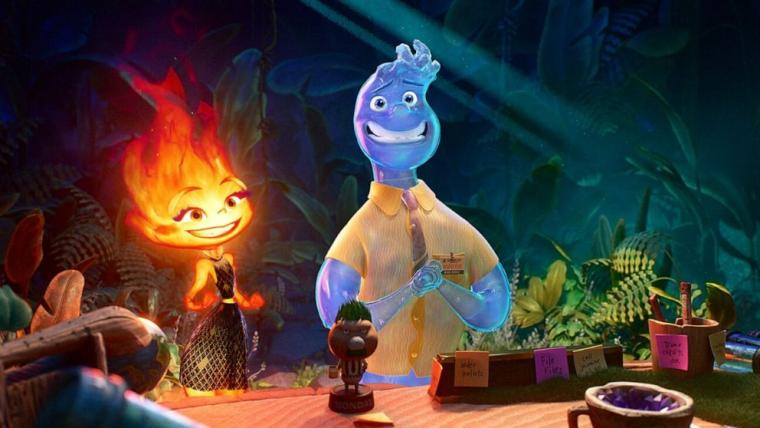
Elemental
ELEMENTAL
Charm counts for a lot, and in Pixar's Elemental, it counts for so much that it's easy to ignore the film's rather lazy stereotyping, strangely under-imagined social dynamic, and plot-goosing crisis that, I'm sorry to say, is all about plumbing issues. Yet in recent years, we've been so sadly bereft of satisfying romantic comedies at the cineplex that director Pete Sohn's animated adventure might just quench fans' collective thirst for a few months. Our leads may not be of flesh and blood, but it turns out that in a pinch, at least under these circumstances, fire and water will do quite nicely.
Set in the bustling, NYC-esque Element City – a metropolis whose citizens are sentient beings composed of earth, air, and the aforementioned fire and water – Elemetal's female rom-com partner is Ember Lumen (voiced by Leah Lewis), a child of first-generation immigrants who, before Ember's birth, left their native realm of Fireland. (So named, I'm guessing, because Fire Island would have inspired a few questions.) Although naturally artistic-minded, Ember is being groomed to take over the management and ownership of her father's bodega – this despite a quick temper that suggests she remain far away from the service industry. On a particularly stressful day behind the counter, Ember snaps, and the subsequent explosion leaves the bodega pipes a wreck and the basement flooded. Enter city inspector Wade Ripple (Mamoudou Athie), a sensitive sweetheart prone to sudden fits of sobbing. He offers some momentary aid yet has no choice but to write up the bodega for numerous violations. Ember is enraged. Wade is stalwart. And even at this early stage, as in most romantic comedies, love is clearly on the horizon. But historically speaking, fire and water are a combination that tends to turn both into smoke and steam. Is a relationship between these cute kids practical, if even possible?
Obviously, we're in the midst of some serious allegory here, and Sohn, who receives a “story by” credit, has stated that Elemental's premise was inspired by his Korean parents' emigration to New York City in the 1970s. (A wonderful prelude set at a makeshift Ellis Island finds Ember's folks renamed “Bernie” and “Cinder” by an immigration official who can't be bothered to spell “Útrí dár ì Bùrdì” and “Fâsh ì Síddèr.”) I should mention that there was probably nothing “obviously” about it to my nine-year-old chaperone, who appeared to accept the goings-on at face value and completely understood why characters composed of glowing flame and translucent liquid should maybe think twice about kissing. It's the grown-ups among us who won't be able to miss the messaging regarding relationships, both romantic and platonic, between members of different cultures, races, and ethnicities, and who might find it all a bit heavy-handed – a Zootopia without the abject hilarity. (Sohn's film could really have used even one scene as funny as Zootopia's priceless routine at the sloth DVM.)
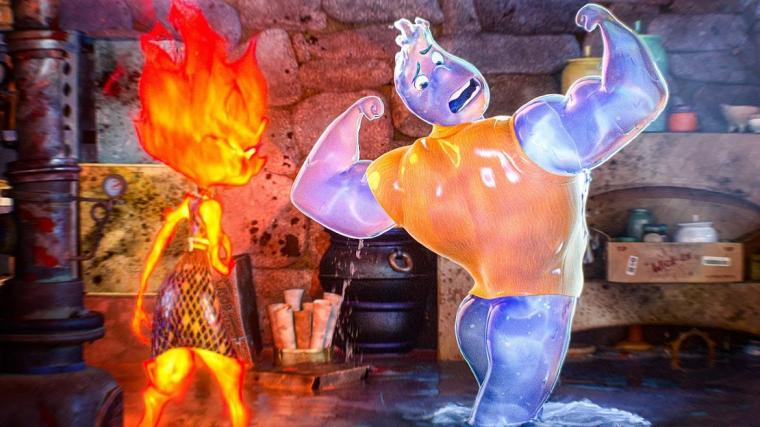
The notion of Elemental's protagonists commingling is so inherently problematic, even potentially life-threatening, that we hardly need to hear Bernie's and Cinder's constant refrains of “Fire and water don't mix!” to get the point. But I'm also not sure that we needed to see Element City's denizens presented as such ready-made clichés. As representatives of the immigrant experience, the fire folk are unfailingly hardworking, obsessively family-oriented, distinctly lower-middle-class, largely humorless, and distrustful of those outside their culture. (The latter, admittedly, for good reason, as the city's monorail system tends to splash down tides of water without regard for the fire creatures walking beneath.) Meanwhile, the water folk – whom the city was evidently built for – are well-to-do, untroubled, mildly bigoted, and entitled in a weekend-at-the-Hampton's sort of way. If you remember the 2002 rom-com Maid in Manhattan with Jennifer Lopez and Ralph Fiennes, that's basically the depth of the culture clash in Elemental, and astonishingly, apart from a handful of sight gags, there's essentially zero interest in the lives of the anthropomorphic earth and air beings. We're given no extended views of their communities or customs or even shared personality traits … . Element City is viewed as a prototypical urban melting pot, but you'd be forgiven for thinking that this particular stew boasts only two ingredients.
Making the absence of fully realized earth and air environments more dispiriting is the fact that, even without them, Elemental looks utterly spectacular – you can't help but wonder whether the visuals might have been twice as arresting given a more expansive design. Still, the distinct boroughs of Element City are beautifully rendered in their minutiae and free-floating jokes (I got a kick out of the “Kiss Me I'm Fireish” T-shirt), and the animation on the water effects is especially rich. I could have done without the pro forma scene of climactic peril as Ember and Wade attempt to save the city from the cascades of a busted dam. Yet there's no denying that the devastation is sublimely watchable, and accompanied by composer Thomas Newman's tender score, there's a gorgeous sequence in which Ember and Wade make their first attempt at physical contact – a gentle rise of bubbles and steam that's like the visual embodiment of those interior butterflies that begin flapping about at the moment of a perfect kiss.
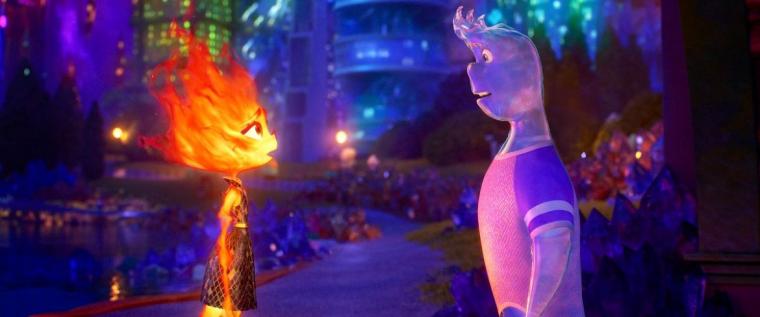
In truth, you might get a tingle of those butterflies throughout much of Ember's and Wade's courtship. I'm not exactly certain how to take their scripted relationship arc, considering that Wade is relaxed around Ember and unashamed of their mutual affection and unafraid to voice his feelings, and it's up to Ember to do all the changing. (Her character flaws wouldn't be so pronounced had Wade not been made so perfect.) Lewis and Athie, though, exude radiant vocal chemistry – she with her determined bluntness that gives way to quiet grace; he with his smooth-as-silk comfort augmented by unmistakable ardor. They're a true joy to listen to, and the animators give their burgeoning romance appropriate visual equivalents; with Ember safely ensconced in a bubble, Wade takes his date on a trek through water-filled catacombs that matches the glory of WALL·E's space dance with EVE. Not coincidentally, Elemental is also Pixar's best (if perhaps first) romantic comedy since that 2008 masterpiece, and unlike the film from 15 years ago, the rom-com heroes here are actually allowed to smile and cry. Over the course of 109 minutes, you may find yourself doing the same.
(Postscript: For major smiling and crying, make sure not to be late for Elemental, or you might miss the 10-minute Pixar short that precedes the feature: Carl's Date, which finds the grumpy hero of Up and his dog with the English-translator flea collar preparing for the old man's first date since Ellie's passing. Between the baked-in nostalgia, riotous “Squirrel!” reference, and surprise of hearing Edward Asner's voice again almost two years after his passing, I was a happy wreck at this thing.)
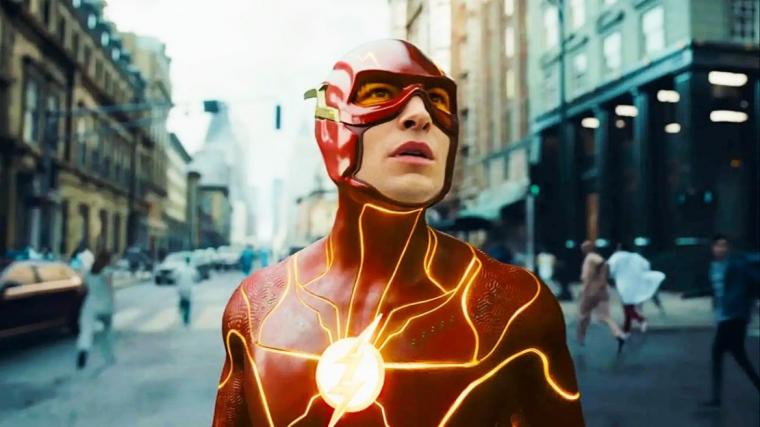
THE FLASH
Before touching on the movie's many, may failings, I feel obliged to say that although the visuals in DC Studios' The Flash are largely terrible, the film does boast the most spectacular “twinning” I've ever seen. As you likely know from the trailers, director Andy Muschietti's comic-book yarn finds our hero in red Spandex using his ultra-speed to travel back in time, where he runs into the 18-year-old-virgin version of his current 28-year-old-virgin self. (This isn't a catty presumption of alter ego Barry Allen's sexual history; it's presented here as admitted fact.) From that moment on, we frequently see Present-Day Flash and Pre-Flash in the same frame, often in physical contact with one another, and the effect is so disarmingly naturalistic that at literally no point did I find myself amazed at the seamlessness of Flash portrayer Ezra Miller sharing scenes with Ezra Miller. Only in retrospect did I realize what a colossal feat this was, so kudos to the artists responsible for the stunning visual trickery. We sure have come a long way from The Patty Duke Show. If only the first-rate twinning didn't mean that we had to suffer through two godawful Ezra Miller performances instead of just one.
I swear this isn't a reaction to the nonbinary performer's widely publicized, deeply upsetting personal scandals in recent years, and I was riveted by Miller in their roles as a dead-eyed high-school killer in 2011's We Need to Talk About Kevin and a gay bestie in 2012's The Perks of Being a Wallflower. But ever since, especially in their performances as the Flash and the Fantastic Beasts series' Credence Barebone, it's become clear that Miller doesn't know how to calibrate a performance anymore – or isn't around any directors who might know how to guide a decent one out of them. Miller is totally acceptable, even touching, in Muschietti's movie whenever they're allowed a moment of sad reflection or heartbroken acceptance. Unfortunately, the pop-eyed Barry Allen of 2023 is required to be almost constantly hyper-agitated and twitchy, and the Spicoli-esque Barry of 2013 is required to be a braying slacker goofus in the manner of Beavis & Butt-Head, and neither interpretation fits into what was once Miller's on-screen comfort zone. What we're consequently stuck with is one hammy, thunderously annoying Flash repeatedly nattering away at another until the film's 144-minute running length begins to feel like a prison sentence. Michael Keaton makes his highly anticipated return as Batman, and Michael Shannon makes a decidedly less-highly anticipated return as General Zod, and all I wanted from these pros was a single scene in which one or both of them slapped Miller(s) across the face and growled, “Calm the f--- down, kid.”
Given Miller's participation and Muschietti's apparent inability to secure a leash with which to restrain his off-the-chain star, The Flash had its work cut out for it from the get-go. Yet while Miller is, as they say, Part of the Problem, they're hardly the whole problem. The trouble begins with the very first action sequence in which the Flash has to save a group of newly born babies from a collapsing hospital. Forget, if you can, that within this massive destruction, we're asked to believe that eight-or-so infants and one shrieking nurse constitute the entirety of the human populace located in that hospital section that's several stories tall. But the tumbling babies themselves look weird. They appear creepily flattened and inhuman, and while the Flash is employing his super-speed to scoot them onto gurneys and stick them into microwaves (for safety!), you realize there's nothing, not even dark comedy, at stake in this melee. The dull advanced-speed presentation is leagues removed from the wit of similar Quicksilver effects in the X-Men movies, the artificiality is neither self-knowing nor suggestive of legit comic-book action, and the newborns look slightly less realistic than that child who crawled around on the ceiling of Danny Boyle's Trainspotting. It's a thoroughly crummy set piece, and one quickly matched in incompetence by the loud, chaotic, incoherent chase involving Ben Affleck's Batman and another DC mainstay whose identity I shouldn't spoil. Oh screw it. It's Wonder Woman. I wouldn't be so pissy about her arrival if this weren't the third smirking Gal Gadot cameo we've had to endure since March.
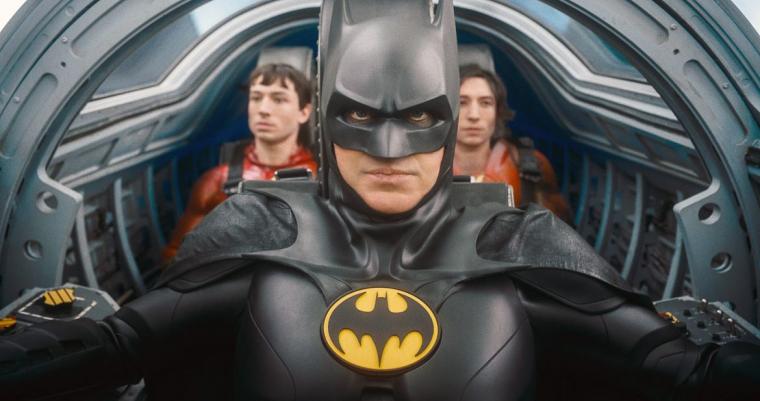
Before the movie was even 20 minutes old, I already hated The Flash. So I was relieved when the meat of the storyline kicked in and involved Barry's decision to travel back in time to prevent the death of his mother (Maribel Verdú) and exonerate his imprisoned father (Ron Livingston) by placing a can of stewed tomatoes in Mom's grocery cart. (Don't ask.) Although this was a peerlessly boneheaded move considering the Butterfly Effect and Barry's supposed intelligence – isn't he a forensic scientist? – the plan at least had some emotional logic. All other forms of logic, however, need not apply. Because after Barry is thrown off course during his speedy trek home, and despite Keaton's facility in describing multiverse theory using uncooked spaghetti noodles, narrative sense is thrown out the window in favor of unrelenting fan service and anything-goes “What If?” plotting, portions of which involve Keaton's Bruce-Wayne-as-latter-day-Howard-Hughes, Sasha Calle's Supergirl, and Kevin Bacon becoming a superstar by playing Pete “Maverick” Mitchell in Top Gun.
That latter revelation made me grin, and The Flash's 2013 scenes – which account for about 85 percent of the movie – featured their fair share of pleasures, chief among them “new” Barry's discovery that clothes tend to quickly melt away when traveling at super-speed. But Spider-Man: Across the Spider-Verse did this whole galaxy-hopping, multiple-realities thing with so much more efficiency, cleverness, and visual/emotional resonance a mere two weeks ago. That animated offering also convinced you that what you were watching on-screen mattered. Yes, it's fun to see national treasure Michael Keaton back in Batman/Bruce Wayne garb again after more than three decades. But even he can't lend conviction to the dreadful comic-book-balloon dialogue and motions he's asked to pull off. (At one point, clearly poking fun at the proceedings, Keaton bellows and throws electric switches like Marty Feldman in Young Frankenstein.) And by the time the meaningless goings-on included the badly rendered visages of other beloved DC portrayers – in one case, a theoretical portrayer – from the '50s onward, I began to think that shamelessness was the guiding principle behind DC's latest; this thing even ends with a casting joke sure to have no future relevance. The Flash moves beyond the speed of light. The Flash seems to last an eternity.
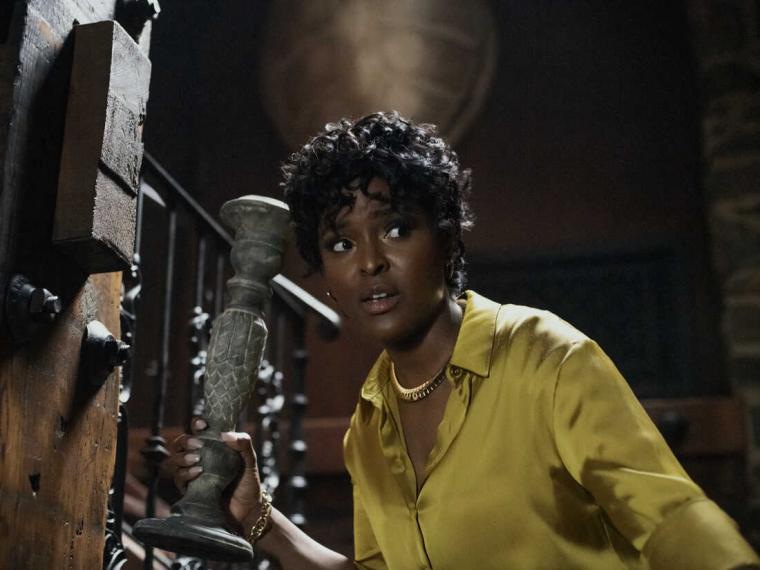
THE BLACKENING
The tale of a half-dozen Black friends who gather at a cabin in the woods to celebrate Juneteenth and find themselves at the mercy of a potentially racist sicko with a crossbow, The Blackening boasts one of the all-time-great poster taglines: “We Can't All Die First.” Anyone with even remedial horror-flick awareness will get the (largely unfunny) joke of this sentiment, and will surely empathize when one of the characters here, to the consternation and “Aw, hell no!”s of her friends, suggests that in order to survive and catch the killer, “We need to split up.” Directed by Tim Story, The Blackening is nothing if not self-aware. Yet delightfully, as opposed to the majority of spoofy Scary Movies released since 2000, it's not self-aware in the manner of “You've all seen the same movies we've seen.” Story's outing is more viciously pointed, and viciously hilarious, than that. This one is more like “We've all seen Get Out … so where do we go from here?”
Jordan Peele's 2017 Oscar winner, it seems to me, is an ideal film to attempt to emulate, partly because there's such rich thematic material to crib from, and partly because Get Out is that rarest of cinematic achievements: a work so iconic, perfectly constructed, and bone-deep satisfying that no one could conceivably think of topping it. (The Sunken Place, which is dutifully name-checked in Tracy Oliver's and Dewayne Perkins screenplay, has officially become as recognizable a make-believe locale as Brigadoon and Shangri-La.) Even though Story doesn't appear much interested in scaring us beyond traditional “Boo!” effects, The Blackening would certainly have benefited from being scarier, and I would have appreciated Jermaine Fowler toning down the facial tics a notch; his performance as the seemingly uninvited guest among the group doesn't leave much room for surprise. Yet I laughed harder at this parody of cabin-in-the-woods thrillers than I have at more than 90 percent of everything else I've thus-far seen in 2023, and with its cast featuring Grace Byers, Melvin Gregg, X Mayo, Antoinette Robinson, Sinqua Walls, Jay Pharoah, Diedrich Bader, co-screenwriter Perkins, and Insecure's terrific Yvonne Orji, this is company I'd have enjoyably kept for far longer than the film's 97-minute running length. Bonus points for the deservedly nasty joke about how many Black guest stars appeared on Friends. Extra bonus points for the final sight gag before the end credits, in which our survivors decide that, because the rescuers don't carry guns, calling firemen for aid is much smarter than calling the police. Our heroes find themselves sadly, riotously thwarted with that choice, too.








